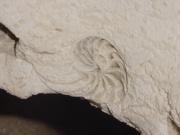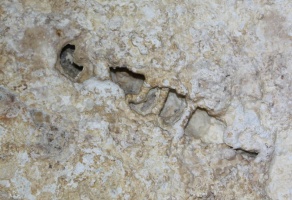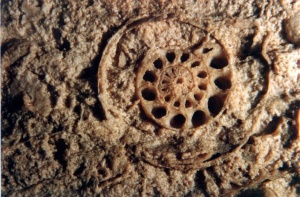Fossils (Inventory)/Cephalopod
From LagWiki
The Cephalopod field should be used to list stations which exhibit cephalopod fossils.
Cephalopod fossils are characterized by a chambered shell. They are coiled in one plane or straight and tapered with internal chambers. They are usually found in exposed bedrock or breakdown and may be obscured in various ways. They could be covered partially or completely by secondary formations and they could be exposed in any direction or in any cross section.
There are two major groups of cephalopods, ammonoids and nautiloids. There is no reason to distinguish these on the inventory form, they are both cephalopods.
Ammonoids have a spiral shell, coiled in one plane with internal chambers that may be wavy or complicated. In vertical cross section, the chambers may appear like a spiral of progressively smaller circular voids. They are uncommon but can be found in various places.
Nautiloids have a spiral shell, coiled in one plane with curved internal chambers. These are commonly referred to as a chambered nautilus or chambered nautiloid. The interior chambers are smoothly curved.
Cephalopods can also have a straight, tapered, not coiled, shell.
If a shell impression is found (not a clam or brachiopod) with internal chambers, it is probably a cephalopod. If there are no internal chambers, it is probably a gastropod. If the interior of the shell cannot be seen, a shell with logorithmically spaced indications of internal chambers is probably a cephalopod. A shell with a smooth exterior or fine, more evenly spaced growth rings is probably a gastropod. If the shell is straight, tapered, and not coiled, it is probably a cephalopod. If the shell is coiled but not in one plane, it is probably a gastropod.
The size of cephalopod fossil impressions can vary greatly.
Cephalopods can leave fossil impressions with no shell. Tentacles like a squid or octopus are the clue to look for. These shell-less impressions are usually hard to recognize and identify, especially in bedrock exposed by dissolution or erosion.
See also
References
- Palmer, Arthur N. (2007) Cave Geology CAVE BOOKS, Dayton, OH pp 71-72 ISBN-13: 978-0-939748-66-2, ISBN-10: 0-939748-66-5
- Coleman, Mary Carol and Cameron Coleman (2010) Fossils of Guadalupe Mountains National Park Carlsbad Caverns Guadalupe Mountains Association pp 13-19, http://www.ccgma.org
Cephalopod, Fossils



